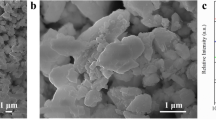Abstract
Corrosion in waste to energy (WTE) plants is an extremely interesting issue, involving complex atmosphere and deposit interactions. In this work, the influence of the complex WTE atmosphere and its various constituents was simulated between 350 and 500 °C in order to obtain a better understanding of the corrosion mechanisms occurring in such atmospheres. For this purpose, the typical flue gas mixture of WTE plants was reduced to simpler systems, and the impact of gaseous species typically contained in WTE plants atmospheres on the corrosion rate of the carbon steel 16Mo3 was investigated. Four different atmospheres were used in this work: “full” WTE atmosphere 0.1%HCl + 0.01%SO2 + 8%O2 + 17H2O + 10%CO2 + N2, 0.1%HCl + 15 ppmO2 + 0.01%SO2 + N2, 0.1%HCl + 15 ppmO2 + N2, and 0.1%HCl + 450 ppmO2 + N2. All exposures were carried out in the temperature range between 350 and 500 °C (30 °C steps) for up to 900 h. Parabolic, paralinear, and linear mass change dependent on time, temperature, and atmosphere was observed, the metal consumption as a function of temperature was determined, and the corrosion scales were analyzed and compared with results of field tests. Finally it is shown that the test results obtained from low-oxygen atmospheres match best the corrosive scales observed in field-tested samples.







Similar content being viewed by others
References
D. P. Miller, H. H. Krause, A. D. Vaughan and K. W. Boyd, Corrosion 28, 1972 (274).
H. J. Grabke, in Incinerating Municipal and Industrial Wastes, ed. R. W. Bryers, Hemisphere, (New York, 1990), p. 161.
R. Bender and M. Schütze, in Solutions of corrosion Problems in advanced Technologies: Proceedings of Eurocorr 1999, Aachen, ed. G. Schmitt, M. Schütze, (1999).
M. Spiegel, Materials and Corrosion 50, 1999 (373).
H. H. Krause, Materials for Energy Systems 7, 1986 (322).
H. J. Grabke, E. Reese and M. Spiegel, Corrosion Science 37, 1995 (1023).
K. Kautz and J. Tichatschke, VGB Kraftwerkstechnik 52, 1972 (249).
M. S. Pasten, “Korrosionsverhalten von Eisen, einem niedriglegierten Stahl, 9% Cr Stählen, Nickel und einem Ni-Basislegierung unter einer simulierten Müllverbrennungsatmosphäre und Chlorid-Sulfat-Ablagerungen bei erhöhter Temperatur.”, Ph.D. Thesis, Universtität Dortmund (2006).
Y. Ihara, H. Ohgame, K. Sakiyama and K. Hashimoto, Corrosion Science 21, 1981 (805).
www.prewin.eu – European Network: Performance, Reliability and Emissions Reduction in Waste Incinerators.
K. Rahts, M. Schorr, C. Schwalm and M. Schütze, Praktische Metallographie 36, 1999 (86).
N. Bertrand, C. Desgranges, D. Poquillon, M. C. Lafont and D. Monceau, Oxidation of Metals 73, 2010 (139).
Z. A. Foroulis, Anti-corrosion Methods and Materials 35, 1988 (4).
R. J. Fruehan and L. J. Martonik, Metallurgical Transactions 4, 1973 (2789).
A. Soleimani-Dorcheh, W. Donner and M. C. Galetz, Materials and Corrosion 65, 2014 (1143).
K. L. Tseitlin and V. A. Strunkin, Journal of Applied Chemistry of the USSR 31, 1958 (1832).
A. W. Henderson, T. T. Campbell and F. E. Block, Metallurgical Transactions 3, 1972 (2579).
M. Schütze and M. Hald, Materials Science and Engineering A 239–240, 1997 (847).
NACE International Standard Recommended Practice—Preparation, Installation, Analysis, and Interpretation of Corrosion Coupons in Oilfield Oparations (2005).
M. J. McNallan, W. W. Liang, S. H. Kim and C. T. Kang, in Proceedings of High Temperature Corrosion, San Diego California, 2–6 March 1981, ed. R. A. Rapp, (NACE, 1981), p. 316.
Acknowledgements
The Federal Ministry of Education and Research (BMBF) is gratefully acknowledged by the authors for supporting this work within the frame of “MatRessource.” Additionally the authors thank Mathias Röhrig for technical support and Gerald Schmidt for the EPMA analysis.
Author information
Authors and Affiliations
Corresponding author
Rights and permissions
About this article
Cite this article
Krumm, L., Galetz, M.C. Chlorine Attack of Carbon Steel Between 350 and 500 °C and Its Importance Regarding Corrosion in Waste Incineration. Oxid Met 87, 757–766 (2017). https://doi.org/10.1007/s11085-017-9749-x
Received:
Published:
Issue Date:
DOI: https://doi.org/10.1007/s11085-017-9749-x




